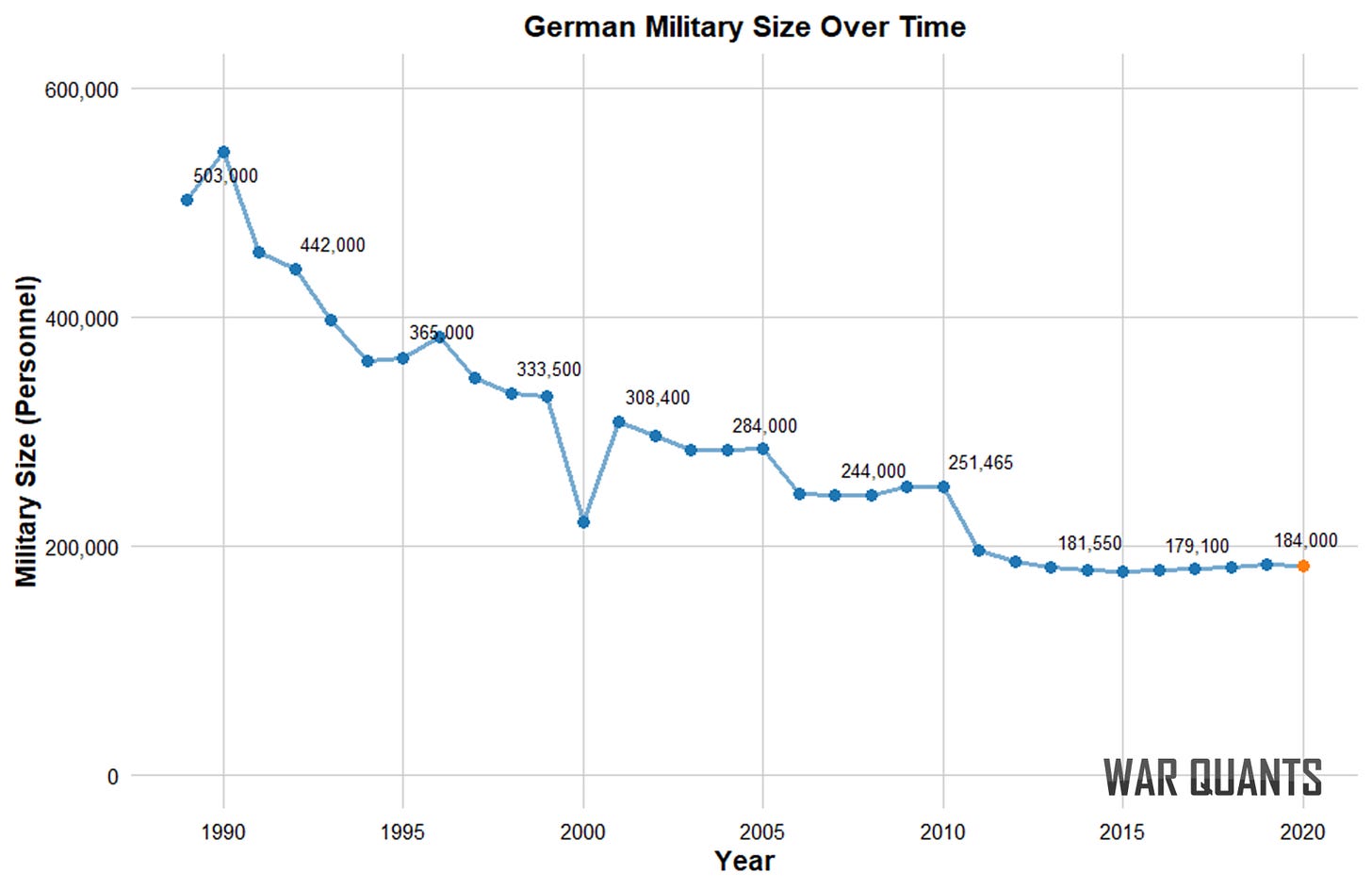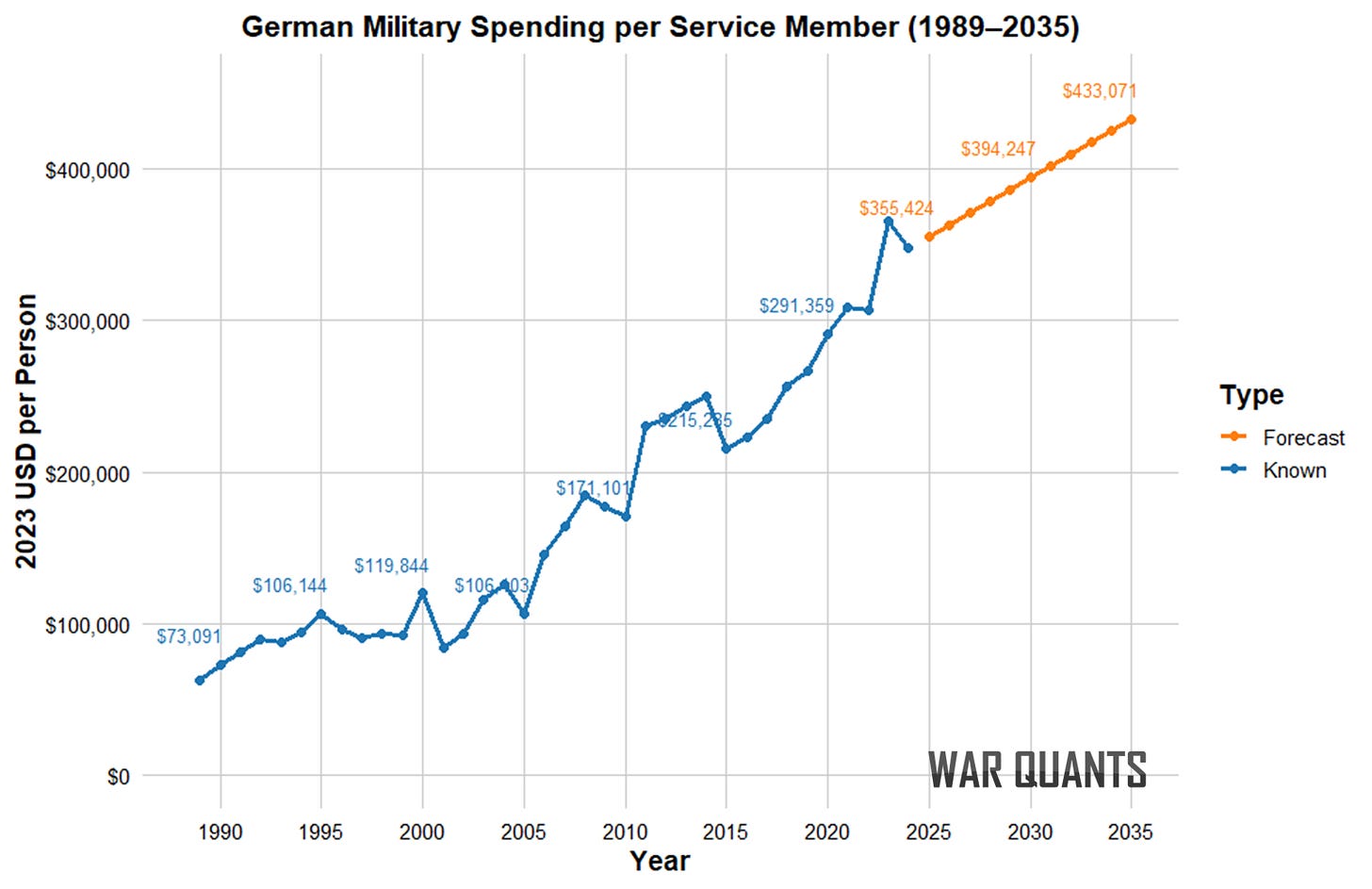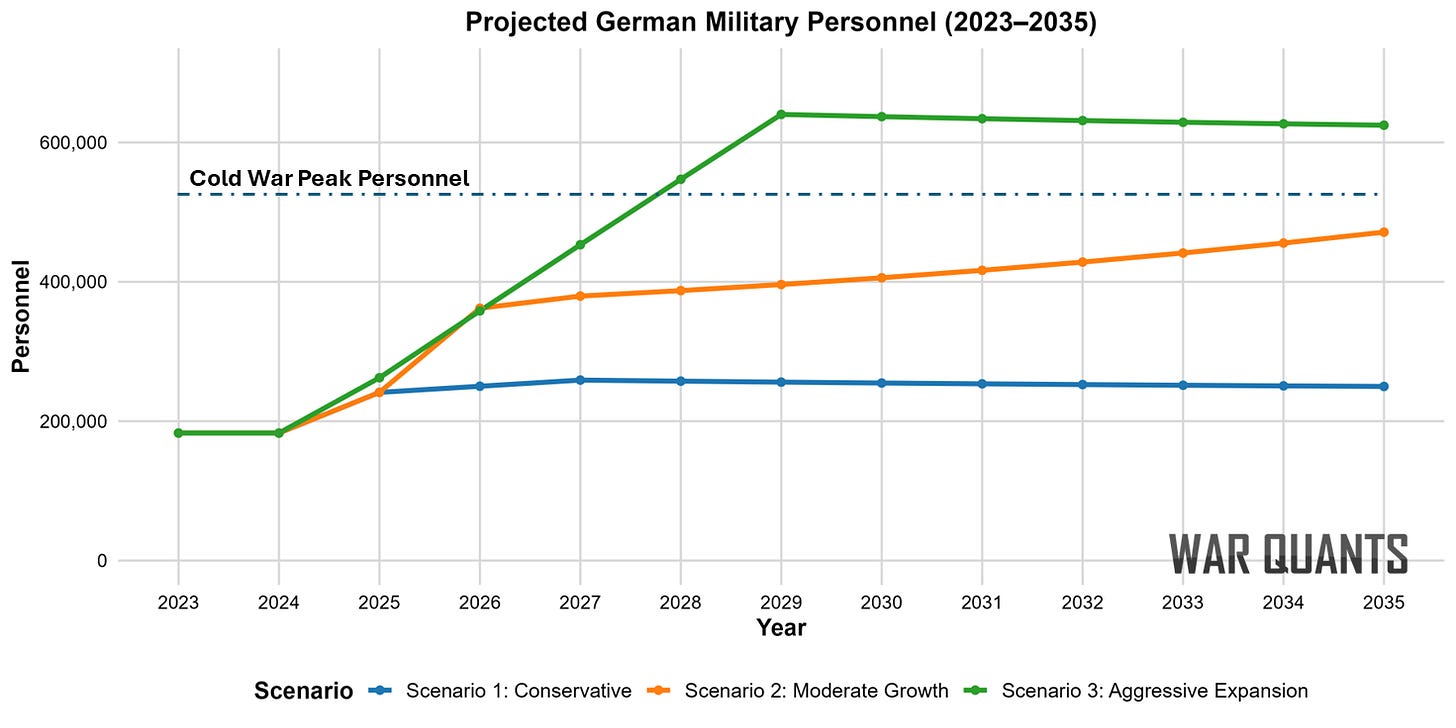Rearmament Along the Rhine
Part 1 of a Series on Rebuilding the German Military
Bottom Line Up Front:
1. Germany is embarking on its fourth major military rearmament in the past 125 years.
2. Berlin plans to invest over $1 trillion over the next decade, potentially expanding the Bundeswehr from 180,000 to more than 400,000 personnel by 2035.
3. A shrinking military-eligible population may increasingly challenge traditional force generation in Germany and Europe as a whole. Autonomous systems may offer a path to a more capable, less manpower-intensive force.
Germany’s war machine showed early signs of sputtering back to life last month with the announcement of a sweeping $1 trillion rearmament plan. If executed, this plan would mark the most significant transformation of the Bundeswehr since the Cold War, positioning Germany at the center of a broader European defense resurgence in response to a shifting geopolitical landscape.

Historic Context
Since unification in the late 19th century, Germany’s military posture has followed a cyclical pattern of rapid buildup and subsequent demobilization. Across three distinct eras — from the last Kaiser, the Third Reich, and the Cold War — Berlin has demonstrated a capacity for fast mobilization, enabled by a deep industrial base and strong state coordination. The current rearmament effort fits within this historical rhythm yet diverges in key ways, particularly in its democratic governance, integration within NATO, and emerging reliance on expensive, advanced technologies over mass mobilization.
The most recent demobilization began with the end of the Cold War, as Germany pivoted from territorial defense to international peacekeeping and stability operations. Over the following decades, the Bundeswehr was reduced from more than 500,000 active personnel to 182,000 today and now represents the 28th largest military globally. This downsizing was reinforced by the suspension of conscription in 2011, which signaled a broader shift toward a leaner, professional force. Notably, this military contraction occurred alongside substantial economic growth, with Germany emerging as Europe’s largest economy, highlighting the growing gap between Germany’s economic weight and military capacity.

While the Bundeswehr shrank in size, German defense spending gradually increased in absolute terms. However, this funding was disproportionately directed toward procuring high-cost, technologically advanced systems and constructing a smaller professional force rather than expanding overall military capacity. As a result, Germany’s military became increasingly expensive to maintain, and yet often lacked deployable readiness and depth. These shifts mirrored broader trends across Western Europe, with nations investing in quality over quantity even as emerging threats began to require both.

To quantify how Germany’s defense spending has evolved for modeling purposes, I have calculated Germany’s defense budget allocated per uniformed service member, shown in the chart below. In 1989, at the tail end of the Cold War, Germany spent the equivalent of $73,000 (adjusted to 2023 dollars) per active-duty member. Today, that figure has ballooned to nearly $350,000. To forecast future military spending across the coming decade, I have also leveraged time-series exponential triple smoothing. Triple smoothing accounts for long-term trends, seasonal variation, and recent accelerations in expenditures. If current trends persist, per-capita military spending could exceed $430,000 by the 2030s.

Many factors contribute to this growth in cost per uniformed person, including the increasing technological complexity of military capabilities and the growing challenges of training and retaining qualified personnel in an increasingly complex military ecosystem amid global demand for technical professionals. For example, the financial incentives necessary to build and maintain competitive human capital may be driving rising personnel costs. The Bundeswehr is also an all-volunteer force in an era with a low propensity for national service.
Future Plans: Scenario-Based Forecasting
To model the Bundeswehr's potential future, I developed a 13-year scenario-based analysis, anchored on defense spending per uniformed service member. Using known 2023 defense expenditures, Germany’s 2025 draft budgetary plans, and historical spending data from 1989 to the present, I have estimated 2024 spending figures and constructed three forecasts through 2035, each based on a different trajectory of political will, fiscal prioritization, and defense commitment.
Scenario 1: NATO Target, Minimal Impact (Worst Case)
Germany meets the NATO benchmark of 2% of GDP in defense spending but significantly dilutes the widely publicized $1+ trillion supplemental rearmament package. A large share of these funds are diverted to non-military priorities, in the same way that the German Green Party recently reallocated $100 billion from defense funding for environmental initiatives. In this scenario, the Bundeswehr remains under-resourced and fails to meaningfully expand or modernize. Force size stagnates, readiness remains limited, and Germany's contribution to NATO deterrence remains primarily symbolic.
Scenario 2: Measured Rearmament (Baseline Case)
Germany meets the 2% GDP threshold and retains approximately 60% of the supplemental rearmament package for actual military use, representing Germany's currently planned trajectory. In this scenario, the Bundeswehr undertakes a substantial expansion, supports modernization programs, and invests in new capabilities such as unmanned systems and cyber defense.
Scenario 3: Strategic Shock Response (Aspirational Case)
In response to escalating global threats and pressure from allies (e.g., former President Trump's proposal for NATO members to spend 5% of GDP on defense), Germany accelerates spending dramatically. Defense investment ramps from 1.8% to 5% of GDP by 2029 and holds that level through 2035. In this high-intensity scenario, Germany rebuilds a scalable, modern force, investing heavily in both manpower and emerging technologies. Germany positions itself as a central pillar of NATO’s European deterrence and power projection capability.
The graph below shows each of the three scenario projections from the model. Scenario 1 drives a small increase in troop numbers over current levels, but does not represent substantive change from the status quo. Scenario 2 ramps personnel levels to over 400,000 by 2035, a meaningful and substantive improvement. Scenario 3 peaks at over 600,000 personnel, representing a transformative reordering of German society and commitment to defense. Under this scenario, the German military would exceed its Cold War troop numbers, with 0.72% of the German population serving in uniform.
The first and third scenarios place plausible lower and upper bounds on future German troop numbers, while Scenario 2 represents a middle ground. Two key observations:
$1 Trillion Enables Real Growth – The proposed $1 trillion supplemental package—if fully allocated to defense—has the potential to scale the Bundeswehr dramatically.
Defense Inflation Outpaces GDP Growth – In both the 2% and 5% GDP spending scenarios, troop numbers initially rise, but decline over time as per-soldier costs continue to outpace national economic growth. This reflects a structural trend: as military equipment, training, and personnel costs inflate faster than GDP, fixed percentages of national output buy fewer soldiers and systems each year. Without sustained increases in real defense spending, force size will atrophy within a decade, even after an initial buildup.
A key modeling assumption in Scenario 2 is that the German government backloads spending, allocating a more significant portion of the $1 trillion package in the later years of the forecast. This approach is designed to offset rising personnel and equipment costs, enabling a more sustainable and gradual force buildup over time. Because Berlin has not yet released a detailed annual appropriation plan for the complete rearmament initiative, yearly budget allocations are estimated using historical defense inflation rates, capital expenditure patterns, and political signaling. This assumption is critical for projecting troop numbers and capability development in the 2030s.
Manpower Constraints: A Strategic Bottleneck
While Germany may successfully allocate capital for rearmament, a critical question remains: does it have the manpower to fill its ranks? The answer is far from certain. According to the German government forecasts, the largest share of the military-eligible population — men aged 18 to 30 —is projected to shrink relative to the aging population by 2030. This demographic cohort, highlighted in the graphic below, forms the core recruiting base for the Bundeswehr. Even under favorable economic conditions and increased defense budgets, force expansion will be severely limited unless Germany reforms its recruitment model, reintroduces some form of national service, or rapidly integrates automation, unmanned systems, and non-traditional personnel models.

Germany’s Rearmament Problem
Germany’s fourth rearmament effort arrives with political momentum and deep pockets—but faces hard limits imposed by demographics, rising per-soldier costs, and labor market competition. Without a scalable approach to manpower and more adaptive force structures, the Bundeswehr may find itself flush with funding yet unable to generate lasting combat power. Rearmament will require more than money — it will demand a rethinking of what a modern, sustainable force looks like in the heart of Europe.
Read More of Our Work Here:
Sustained Russian Shahed Swarms: The War of Precision Mass Continues
Damn the Torpedoes: Smaller, Cost Efficient, Less-than-Lethal Systems
One Million Suicide Drones with Chinese Characteristics
Capability Analysis: AI Machine Guns for Drone Short-Range Air Defense
The views and opinions expressed on War Quants are those of the authors and do not necessarily reflect the official policy or position of the United States Government, the Department of Defense, or any other agency or organization.
End Note:
German Military Size Graphic Sources:
Müller, Rolf-Dieter (2016). Hitler's Wehrmacht, 1935–1945. Lexington: University Press of Kentucky. ISBN 978-0-81316-738-1.
Finding accurate and transparent data was difficult. Early Germany military size estimates from World War II and before may not capture the full size of the entire armed forces, including the German Navy.





Extremely good analysis. How are you gathering your data for these?
Excellent work.
IF …
Most likely scenario 1) they’re going to stea… reallocate the money. They’re probably cleaning out the safe as the government and parties they have are finished. Pensioners aren’t going to have a Make Germany Great Again revolt and AfD is shut out. Most likely this is it for Europe.